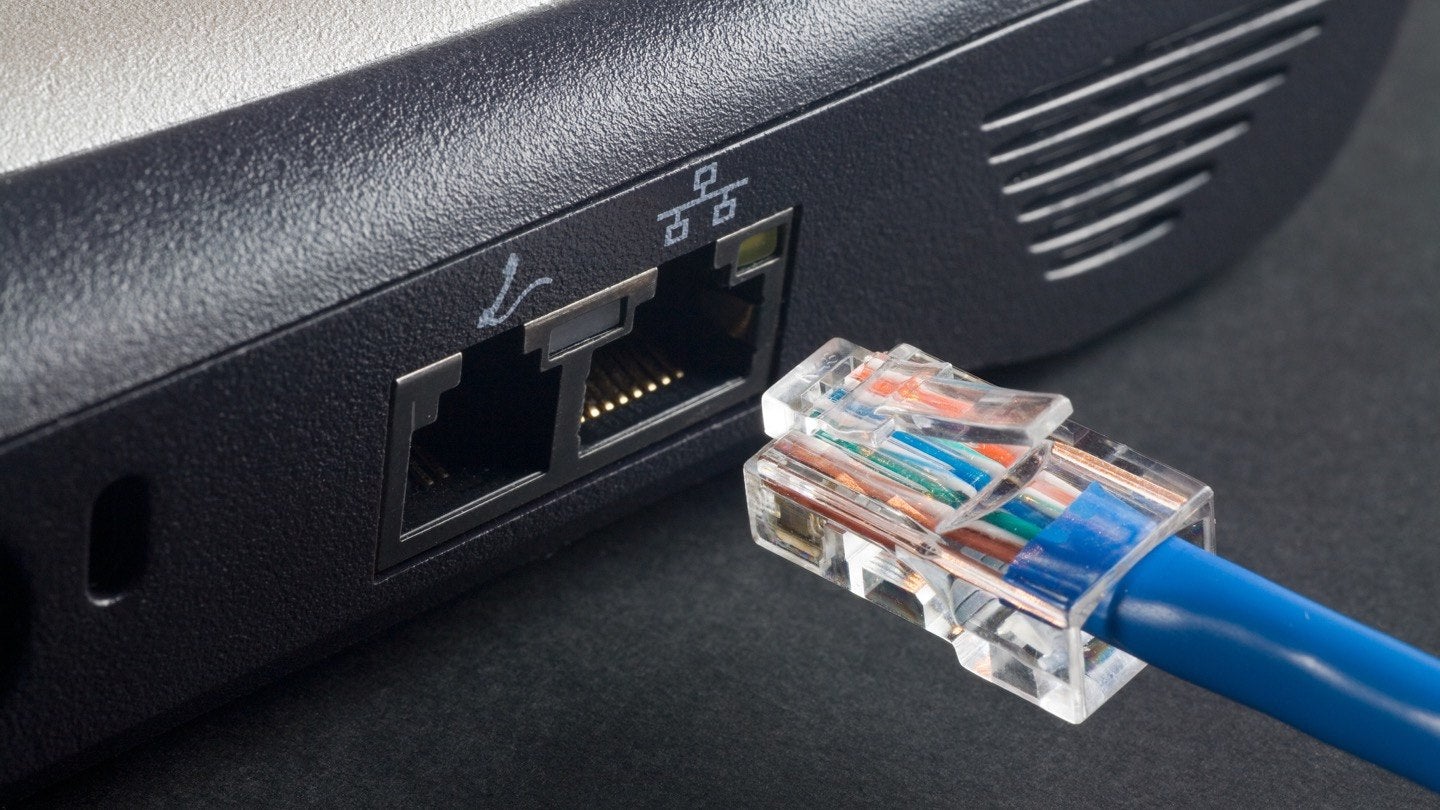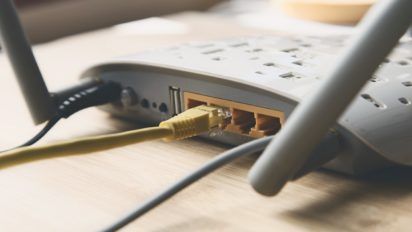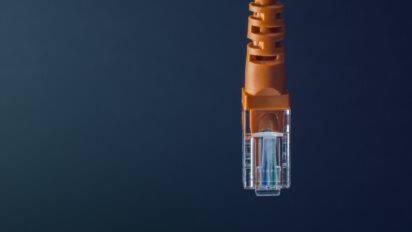At a glance, Ethernet cables appear to be little more than bulky phone cords. They are vastly different, however, and the type of Ethernet cable you use can impact your internet connection and speeds.
Ethernet cables come in different categories, each identified as “Cat” followed by a number. The most common Ethernet types are:
- Cat 5e
- Cat 6
- Cat 6a
- Cat 7
- Cat 7a
- Cat 8
Understanding the capabilities of each cable category is important when choosing the right one for your home. Learn more about Ethernet cable speeds and categories to identify the best one to set up your high-speed internet service. Ethernet is a local area network comprised of two or more devices connected within one place. It’s an often faster option than using a Wi-Fi network.
Ethernet cable category quick comparison
| Category | Max Speeds | Bandwidth | Starting price |
|---|---|---|---|
| Cat 5e | 1,000 Mbps | 100 MHz | Less than $10 |
| Cat 6 | 1,000 Mbps | 250 MHz | $10-$15 |
| Cat 6a | 10,000 Mbps | 500 MHz | $15-$20 |
| Cat 7 | 10,000 Mbps | 600 MHz | $15-$25 |
| Cat 7a | 10,000 Mbps | 1,000 MHz | $25-$35 |
| Cat 8 | 40,000 Mbps | 2,000 MHz | $7 and up |
Cat 5e – oldest version still available
Cat 5 is hard to find and very outdated. Low-cost and capable of supporting gig internet, Cat 5e (Cat 5 “enhanced”) supports up to 1,000 Mbps and is built to reduce crosstalk — unwanted transfer of signal between the cables — for a more consistent connection. This is the most common type of Ethernet cable because it supports speeds up to 1 Gbps and typically costs less than Cat 7 or Cat 8 cables.
- Estimated price for 12-ft. cable: Less than $10
- Go with Cat 5e if: You want an affordable cable that will do the job.
- Upgrade to a Cat 6 if: You want higher bandwidth and the option of a “shielded” cable, which reduces crosstalk and signal interference.
Cat 6 – higher bandwidth, possibly shielded
Standard Cat 6 cables support the same speeds as Cat 5e but give you more than double the bandwidth. The higher bandwidth helps reduce download and upload times, especially if you are transferring files from one computer to another via a Cat 6 cable.
Another potential benefit of Cat 6 cables is shielding. This is a thin protective barrier around the wires inside the Ethernet cable, which further protects them from crosstalk and interference. Not all Cat 6 cables come with this feature, so look for “STP” or “shielded twisted pair” when shopping for Cat 6 cables.
- Estimated price for 12-ft. cable: $10-$15
- Go with a Cat 6 if: Your internet plan speeds are 1,000 Mbps or less and you want higher bandwidth for faster downloads and uploads.
- Upgrade to Cat 6a if: You have an internet plan with speeds above 1,000 Mbps or anticipate getting a faster plan in the future.
Cat 6a – 10x the speeds, double the bandwidth
Cat 6a (Cat 6 “augmented”) gives you a big jump in both speeds and bandwidth over the Cat 5e and Cat 6, supporting up to 10,000 Mbps and 500 MHz. Plus, all Cat 6a and higher cables feature shielding designed to eliminate crosstalk almost entirely.
Though probably more than the average user needs, Cat 6a cables will deliver a fast, reliable connection. It’s also safe to say this cable will support your high-speed internet connection for years to come, even as faster cable and fiber-optic internet speeds become available.
- Estimated price for 12-ft. cable: $15-$20
- Go with Cat 6a if: Your internet plan speeds are higher than 1,000 Mbps. You want a cable that likely won’t be outdated in two to three years.
- Upgrade to Cat 7 if: You want a cable that supports slightly higher bandwidth and will cost you around the same price as a Cat 6a cable.
Cat 7 – a little higher bandwidth than Cat 6a
Cat 7 cables are some of the latest generation of Ethernet cords available but have little to offer compared to Cat 6a aside from slightly higher bandwidth. Both support speeds up to 10,000 Mbps, but the Cat 7 supports 600 MHz of bandwidth compared to the 500 MHz of Cat 6a. The higher bandwidth frequency does allow for faster data transfers, so if you plan on downloading or uploading large files, the extra bandwidth the Cat 7 gives you may be worth it.
- Estimated price for 12-ft. cable: $15-$25
- Go with Cat 7 if: Your internet plan speeds are higher than 1,000 Mbps and want a cable that supports high bandwidth.
- Upgrade to Cat 7a if: You want a cable that supports the highest bandwidth available.
Cat 7a – even more bandwidth
Like the Cat 6a and Cat 7 cables, the Cat 7a supports Ethernet cable speeds up to 10,000 Mbps, but the max bandwidth is much higher at 1,000 MHz. Again, this cable is probably much more than the average user needs, but it’s ideal for those who want the best cable now and a great one for future internet services.
- Estimated price for 12-ft. cable: $25-$35
- Why choose Cat 7a: You want the top-of-the-line connection and don’t mind paying a little more for it.
Cat 8 – the fastest cable
Cat 8 is the highest-performing Ethernet cord available. It is the recognized standard “after Cat 6, having faster throughput over short distances: 40 Gbps up to 78’ and 25 Gbps up to 100’,” according to telco-data.com. Its bandwidth goes to 2000 MHz.
- Estimated price for 12-ft. cable: $7 and up
- Why pick Cat 8: This high-performance cable is suited for data-center type needs.
Tips for choosing the right Ethernet cable
Along with identifying the right Ethernet cable type for your internet service, there are a few other factors you may want to consider when shopping for the right one for your needs.
Consider the length
Ethernet cables come in many lengths, ranging from three to 300 feet or more. Think about the proximity of your router and the devices you want to connect to get a cord with sufficient length. Remember that running the cord along baseboards or through the walls will take up more length.
Choose pure copper cables
Ethernet cord manufacturers use either pure copper or copper-clad aluminum. Pure copper will give you a better connection, so look for “pure copper wire” or “TIA 568-C22” on the packaging. The copper-clad aluminum, identified as “CCA,” might be a little cheaper, but it won’t give you the same quality connection.
How durable are Cat cables?
Most cables have a lifespan of five to seven years and are rated by their materials. According to New York Cables, plenum-rated cables are the best. “Because of the fire-resistant and low smoke emitting characteristics of the plenum-rated jacket, Ethernet cables with this jacket will last longer than any other type of Ethernet cable.” Be aware the PVC cables will wear more quickly than other types.
Speed and your choice of cable
Your choice of Ethernet cable should be compatible with your internet speed. For instance, you may want to upgrade older Cat 5 or 5E cabling to 6a or 7a for faster internet plans since 5 only supports up to 1 gig with 100 MHz, and the newer categories go beyond 10 gig and 2000 MHz.
Ask what your installer is giving you
Your internet installer often comes with an Ethernet cord to hook your modem up to your router. Ask what kind of cable the installer uses, and request one of better quality if it’s not the best one for your connection.
Find broadband news and studies on trends in the industry on Allconnect’s news hub and research hub.
FAQs
First determine the current speed of your internet connection. If you have less than 100 Mbps of speed, then a Cat 5 should work. Anything above Cat 5 should support speeds up to 1,000 Mbps, and Cat 7 and 8 are built to support fast multi-gigabit Ethernet speeds.
The different categories of Ethernet cables determine the amount of speed and bandwidth they support. Cat 5 is an older standard and should only be used for 100 Mbps internet plans or less, but Cat 7 and 8 are built for extremely high Ethernet speeds.
It depends on your needs. Flat Ethernet cables are useful underneath carpeting or flooring and are great over short distances to your router. But there are little to no differences in the performance between a flat and round cable.

Written by:
Camryn Smith
Cammy is a writer with Allconnect, growing her broadband industry knowledge for over a year on the internet marketplace. Her expertise lies in home internet and broadband service with a focus on providers, plans…
Read more
Edited by:
Robin LaytonEditor, Broadband Content
-
Featured
![Everything you need to know about internet speeds]() Everything you need to know about internet speeds Robin Layton — 11 min read
Everything you need to know about internet speeds Robin Layton — 11 min read -
Featured
![Where is the best place for your Wi-Fi router?]() Where is the best place for your Wi-Fi router? Camryn Smith — 5 min read
Where is the best place for your Wi-Fi router? Camryn Smith — 5 min read -
Featured
![Wi-Fi not cutting it? Ethernet cables may be the solution to your home internet connectivity problems]() Wi-Fi not cutting it? Ethernet cables may be the solution to your home internet connectivity problems Lisa Iscrupe — 4 min read
Wi-Fi not cutting it? Ethernet cables may be the solution to your home internet connectivity problems Lisa Iscrupe — 4 min read
Latest
-
Wednesday, April 24, 2024
Why do you need an Optical Terminal Network?Taylor Gadsden — 2 min read
-
Tuesday, April 23, 2024
Worried about losing your TV signal? This is how to keep your satellite dish cleanDavid Anders — 6 min read
-
Tuesday, April 23, 2024
How to change your Wi-Fi network passwordCamryn Smith — 2 min read






